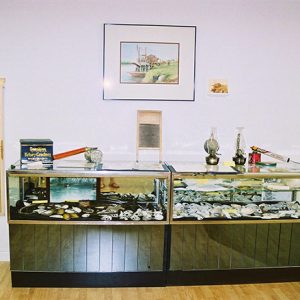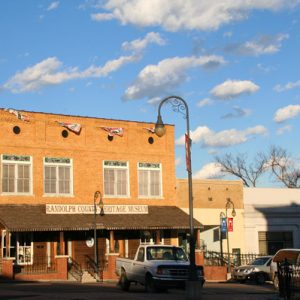calsfoundation@cals.org
Randolph County Heritage Museum
Located on the historic court square in Pocahontas (Randolph County), the Randolph County Heritage Museum officially opened in 2006 during the Pocahontas Sesquicentennial Celebration and is owned by Five Rivers Historic Preservation, Inc., a non-profit, volunteer organization dedicated to the preservation and celebration of Randolph County history and culture.
The museum includes three room-sized exhibits. The River Room is dedicated to the five rivers of Randolph County and their contributions through transportation, industry, recreation, and support to the local economy. The largest of the five rivers, the Black River, supplied the shelling and pearling industry of the late nineteenth century through the mid-twentieth century. Included are a working button machine and a collection of original tools and implements, as well as a step-by-step exhibit of mussel shells and the process by which they were turned into buttons. Additionally, a collection of pearls found in the Black River is on display. The walls are lined with photographs of steamboats, bridges, barges, and other testaments to the river era. The centerpiece of the room is a seven-foot alligator gar caught in the Black River in the early 1950s.
The Medical Room is dedicated to the early practice of medicine in Randolph County. Examination tables, chairs, and a one-of-a-kind X-ray machine line the walls. Two display cases are filled with pharmaceutical utensils, bottles, old measuring tools, and more. Portraits of many of Randolph County’s early physicians, some going back to the Civil War era, are on display. Receipt books and an early record book for the Randolph County Medical Society (circa 1910) are also displayed.
The third main exhibit, which is found in the Artifacts Room, is dedicated to the archaeological finds from Davidsonville Historic State Park, located a short distance southwest of Pocahontas along the Black River. Established in 1815, the town of Davidsonville was the first county seat of Lawrence County (from which Randolph County was separated in 1835) and the home of the first post office, courthouse, and land office in Arkansas Territory. The artifacts on display at the museum were found during Arkansas Archeological Survey digs of recent years. The Artifacts Room has been filled with temporary exhibits and display cases that commemorate the history of public school education and high school athletics of Randolph County.
Additionally, the museum hosts exhibits dedicated to the cultural heritage of the Ozark foothills: a wool spinning wheel and nineteenth-century quilts, an old organ from the historic St. Paul’s Catholic Church, items constructed from flour sacks (quilts, dolls, etc.), as well as exhibits dedicated to the Civil War, World War I, and World War II, along with several area community exhibits. Rotating exhibits are scheduled throughout the year.
For additional information:
Randolph County Heritage Museum. http://www.randolphcomuseum.org (accessed September 28, 2022).
Cindy Robinett
Randolph County Heritage Museum
 Randolph County Heritage Museum
Randolph County Heritage Museum  Randolph County Heritage Museum
Randolph County Heritage Museum  Randolph County Heritage Museum
Randolph County Heritage Museum 




Comments
No comments on this entry yet.